Solving The District Of Columbia Problem
There's only one solution to the D.C. statehood issue. It's called retrocession.
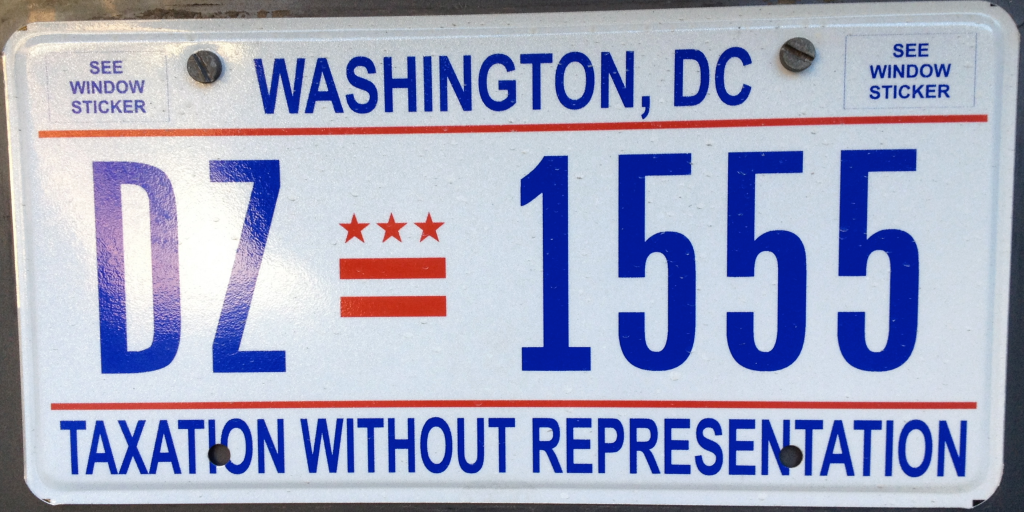
The Washington Post’s Charles Lane offers what seems like the only feasible solution to the issue of representation in Congress for residents of Washington, D.C.:
Of all the perennial structural issues plaguing American democracy, providing full congressional representation for the District of Columbia’s 700,000 residents must be the most maddening.
It is an anomaly both patent and easy, so easy, to solve. The answer is right there in Douglass County, Md.
To save you some Googling time: Douglass County is not a real place — yet. Rather, it is the new jurisdiction that would be created by returning the residential portions of the District to Maryland, a process known as “retrocession,” conceived by third-generation Washingtonian and policy gadfly David Krucoff.
The genius of Krucoff’s plan is to sidestep all the difficulties, political and constitutional, of creating a new state, or state equivalent, out of the District, and instead to simply allow its people to share the representation Maryland already has.
Retrocession could be accomplished by a combination of federal and state legislation, just as it was in 1847, when the federal government ceded the portion of D.C. south of the Potomac River back to Virginia. No constitutional amendment required.
As a large and influential new population center within Maryland, the people of Douglass County would have a member of Congress to look out for their interests, plus two senators, just as they would if D.C. were a state. Problem solved!
To discuss the matter with Krucoff, as I did over lunch downtown recently, is to experience the full conversational force of a Man With a Plan. Though he operates a real estate business, it is quickly evident that Douglass County is this intense 50-something’s true passion.
“Unlike some other crazy ideas out there,” he said, “this one is so clearly a good idea.” He certainly chose a clever name for his imagined jurisdiction — both an homage to Frederick Douglass, the African American abolitionist with deep personal roots in the District and Maryland — and a clever play on the city’s existing moniker. “D.C.,” get it?
For the past couple of years, Krucoff has campaigned 25 hours a week for Douglass County, including visits to 38 of the 40 Advisory Neighborhood Commissions in the District and lobbying various elected officials around the region.
One such pol smiled, looked him in the eye and, according to Krucoff, gently told him: “We’re not going to do this, David.” The dose of realism made no impact that I could discern.
Krucoff prefers to focus on the larger number of officials who, he claims, privately agree with him but don’t dare say so publicly. They are, in his phrase, “closeted retrocessionists.” Perhaps someday, if statehood keeps failing, they will come out.
(…)
The central objection to retrocession is that it fails to give voice to the District’s unique culture and interests. There’s something to that, but Douglass County’s 700,000 people would be dominant within a new Maryland congressional district and have a huge influence over the election of Maryland’s U.S. senators — not to mention having a large delegation in the state legislature.
Crucially, a Douglass County state’s attorney would replace the U.S. attorney in matters of criminal law, restoring local autonomy in that area as well.
As Douglass County regained control of prosecutors and courts, it could meanwhile shed multiple layers of bureaucracy — including the Department of Motor Vehicles, Metro and Medicaid — that the District currently maintains because it would no longer be individually responsible for those statelike functions. Maryland would take over.
Maryland has traditionally opposed retrocession for precisely that reason, but cost concerns are decreasingly credible given the District’s economic boom. Any burden of administering the needs of the District’s population, including its poor, could be offset by the huge increase to Maryland’s tax base from incorporating wealthy precincts such as Ward 3.
The federal government ought to be willing to grease retrocession by supplying transitional aid, possibly by reprogramming annual grants to the District.
Krucoff’s plan includes a neat diagram tracing the small, residual “federal city” — basically, the Mall, monuments, Capitol and White House — that would remain as “the Seat of the Government of the United States” called for in Article I of the Constitution.
Here are graphics from the website supporting the idea showing what would be “Douglass County, Maryland,” and what would make up the Federal District (which I suppose could retain the name “District of Columbia” or “Washington, D.C.” but which could also be renamed to something like the “District of Washington”:
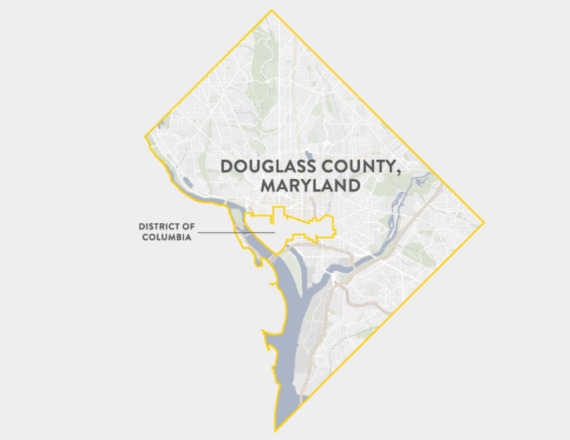
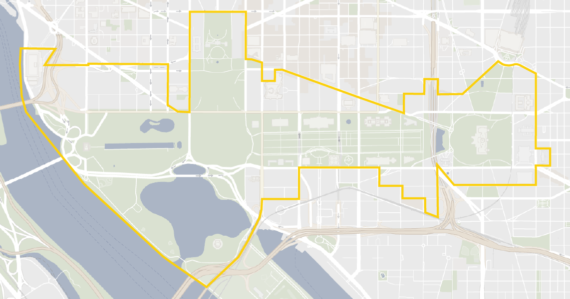
Retrocession would not be an unprecedented action, specifically with regard to the Federal District. When the District of Columbia was first formed during the Washington Administration, it included land from both Maryland and Virginia. However, it was understood at the time the Federal Government itself would be based in that part of the land made up of the portion of land ceded to the Federal Government by Maryland. The Virginia portion, meanwhile, would have presumably become land for residential and business development. Before that could occur, though, the Federal Government concluded that it did not need the land that Virginia had ceded for its contribution to the Federal District. As a result, in 1847, the United States returned Virginia’s portion of the Federal District. That area now includes the majority of Arlington County, which has become a metropolitan area all its own as well as the home to some 235,000 people and the location of employment for tens of thousands of more people. This is the area, for example, that includes what is presently known as Crystal City, which is where at least part of Amazon’s new HQ2 will be located. It also includes some parts of Alexandria, Virginia, one of the oldest cities in the area.
In theory, this is the same thing that could happen to the non-Federal areas of Washington, D.C. With the exception of the small area of the city where the Federal Government is located, none of which includes any residents other than the President and his family, the rest of the city would be returned to the State of Maryland where it would have its own Member of Congress who would have a vote on the floor of the Senate, and would be able to participate in the election of Maryland’s two Senators. It would also add at least one Electoral Vote to the total number of such votes that Maryland currently has. Additionally, as Lane notes, other advantages to the District residents in that it could save money on certain agencies that already exist in Maryland, such as the Motor Vehicle Commission and other similar departments. Of course, the most likely development is that most of these Washington, D.C. offices would simply change their name and that current employees would become employees of the State of Maryland. Additionally, Douglass County would, with 700,000 residents, become the fourth most populous county in Maryland, ranking behind Montgomery and Prince George’s County in what is now Suburban Maryland and Baltimore County.
All that being said there are several complicating factors, most of them political. A move like this would require the agreement of the governments of both the District and the State of Maryland Right now, politicians in the District are still hanging their hats on the dream of statehood and it would take some walking back to get them to support retrocession. Realistically speaking, though, statehood for the District of Columbia in and of itself is unlikely to happen any time soon. Such a move would require the approval of both the House and Senate, and there’s simply no way that Republicans are going to permit statehood, which would effectively add two permanent Democratic seats to the Senate. Additionally, as Dave Schuler points out in a post unrelated to Lane’s article that also basically endorses the idea of retrocession if statehood is granted to the District of Columbia, then what about every city with populations larger than the Districts? According to this list, that includes some 19 other cities ranging from New York City to Denver, Colorado. Are all these jurisdictions entitled to statehood too? Of course not. WIth retrocession, the citizens of the District of Columbia would get the Federal representation they are entitled to, and the absurdity of a city-state with equal representation in the Senate to California would be avoided.
The other complication could come from the state of Maryland itself, whose legislature would need to approve the retrocession of the non-Federal parts of the district. In that regard, one complicating factor could be the fact that adding 700,000 people to the State of Maryland would represent a significant shift of political power from the eastern part of the state, which primarily means Anne Arundel and Baltimore Counties to the southern parts of the state, where Douglass County, along with Montgomery and Pince George’s County, would form a significant power base that would likely represent a shift of power in the state. There would also be costs associated with retrocession, of course, but as Lane notes, Congress could kick in money to make up for that. There’s nothing Congress could do that would deal with this shift in political power, and this could cause legislators from other parts of the state to object to the idea.
As Lane notes, there’s also one other complicating factor, and it comes in the form of the 23rd Amendment. That Amendment grants the “District of Columbia” three Electoral Votes in Presidential Elections. If the population of Washington, D.C. were to become citizens of Maryland, this Amendment would obviously become moot, but it would still be on the books and would arguably still apply to the Federal District even though that area would not be comprised of any permanent residents other than the President. The easiest solution, of course, would be to repeal the Amendment simultaneously with the act of retrocession, otherwise, the President would theoretically at least end up with being entitled to three Electoral Votes all his own.
All that being said, retrocession is, in the end, the only realistic solution to the problem of non-representation for residents of the District. If we want to solve that problem, then we’re going to have to find a way to accomplish it.

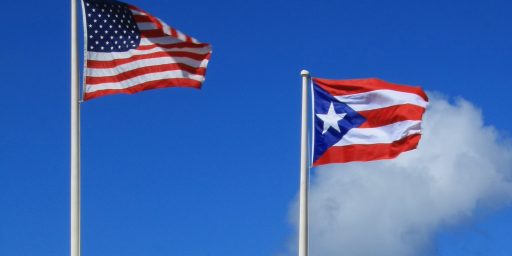
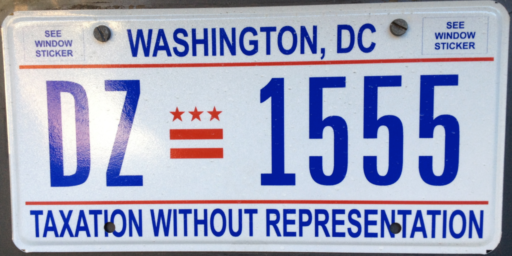
I’ve argued for retrocession here going back at least as far back as June 2003—just months into OTB’s existence.
@James Joyner:
The obstacles to this eminently practical solution appear to be politicians in Annapolis who are likely uneasy about upsetting the political balance of power in Maryland, and politicians in D.C. who continue to fill their constituents heads with dreams of statehood that will never come.
@Doug Mataconis: Agreed. While I can see Democrats wanting to add another two Senators to their slate there’s really no good reason to grant statehood to a smallish city—or to continue denying them representation in Congress.
Retrocession is obviously the right solution. The only way that DC statehood makes any sense is if we made every U. S. city larger than Mesa, AZ a state, too.
It may be a practical plan, but only in the sense that it could work within, and reinforce, an outdated political system. States don’t mean anything. Their boundaries are absurd. States are little, mini-countries with borders as random and meaningless as anything Sykes and Picot drew. What do Cairo, Illinois and Chicago have in common? What differentiates Iowa and Nebraska? What is the logic in having some states with the GDP of France and others with the GDP less than that of any six square blocks of Manhattan? It offends my sense of reason that we are stuck with these unreasonable political entities.
Easy peasy. Somehow over the years I’d gotten the impression repealing an amendment would be hard, 3/4 of the states or a convention or somthing.
Ds agree to lose three safe Electoral College votes (OK, two if we assume MD picks up a Rep and is safe D) in return for….
@Dave Schuler:
If you’re worried about disproportionate influence, we would also need to roll together Idaho, Montana, North Dakota, South Dakota, and Wyoming into the new State of Norland…
This makes sense so of course it will never happen.
Population of Wyoming: 579,315 (2017)
Jus’ sayin’.
@DrDaveT: Why did Dakota Territory get split into two low population states in 1889? Four R Senators instead of two.
@OzarkHillbilly:
And 93% White, too.
Retrocession makes sense, therefore it won’t happen.
A friend keeps linking me to articles regarding the proposed merger of the City of St Louis and St Louis County (the split goes back to the Civil War). It makes sense he says, it will save millions of dollars the political and business leaders love the idea. Nay, say I. The entrenched interests won’t let it happen no matter how good the idea is and retrocession for DC is another idea whose time will never come.
@Michael Reynolds: I think Doug disagrees but Steven Taylor and I have long argued for getting rid of the Electoral College and the Senate is essentially the same issue. While I think there are issues where local rule makes sense, I think states should do far less than they do now. But I see no practical way to rid ourselves of the system given the way the Constitution is amended.
@gVOR08:
You do realize that there would be nobody to cast votes for the “Federal District” in the event that the residential parts of D.C. are retroceded to Maryland, right? The Democrats would not automatically get those three Electoral Votes.
@James Joyner: “there’s really no good reason to grant statehood to a smallish city”
A smallish city that has roughly the same population as North Dakota.
Maybe we should also use retrocession to combine both Dakotas into one, still tiny and insignificant, state.
@wr: Apparently everyone in the world beat me to this. That’s what I get for responding before reading all the comments…
If the concern is to gain representation without creating a new state, then this appears to be an elegant and simple solution.
Change approved!
A DC state would be more populous than Vermont and Wyoming.
@Michael Reynolds:..What do Cairo, Illinois and Chicago have in common?
Political corruption…
See:
In corruption-plagued Chicago, high-level shakedown charges loom over mayoral race, candidates
and
Former Alexander County Housing director must pay HUD $500K after using federal money on travel, gifts
Quite enough thankQ
The problem with retrocession is that neither Marylanders nor Washingtonians want it and that’s democracy for you. The reality is that DC has evolved into a de facto territory with its own identity. Statehood truly is the only status that makes sense.
My preferred solution has always been to give the DC representative a vote — since he or she represents the people — but not Senators since those represent the states.
@OzarkHillbilly: For all of you Hee Haw fans out there…
@Hal_10000:
Senators does not represent the states, they are a deliberative body to balance the lower house, that’s supposed to be more volatile. In many countries Senators are not even elected by state, province, regions or department.
By the way, the United States is the only country in the Americas where people living in the capital city does not elect representatives to Congress. Both in Argentina, Mexico and Brazil people living in the federal district elect Senators and Congressmen like any other state or province, and these countries modeled their political systems after the US.
Don’t be so sure. If the Dems take over both houses and the presidency, DC and Puerto Rico are becoming states.
Yes, that also means the filibuster is gone. McConnell has taught a very clear lesson that there is no reason to not do what makes sense.
@Doug Mataconis: That was my point. The Democrats almost automatically get those 3 EC votes now.
I trust no one’s serious about letting Donald and Melania have the 3 DC EC votes (are there no live in staff at the WH?). For this retrocession plan to work, the 3 DC electoral votes would have to somehow be eliminated, cutting the EC from 538 votes to 535. This is a precondition for retrocession, no matter how difficult it might prove to be.
In 2016 Hillary carried DC by like 85% and received the Districts 3 Electoral votes. She also carried Maryland by about 25% and received their 10 EC votes. 13 total. Under this scheme Hillary would have received only 10 from the same population. (If MD picked up an extra House seat, and therefore an extra Elector, with the added population, maybe 11.)
The Democrats lose 3 (maybe only 2) exceptionally safe EC votes. At best, they might get one House seat. Why should they agree to this?
@Hal_10000: “since he or she represents the people — but not Senators since those represent the states.”
Really? How does that work? I get what it means to represent the people — ideally, they listen to what the citizens want or need and work to provide it. But how do senators know what the states want or need separate from their citizens? And what does an arbitrarily defined land mass want when it comes to representation?
Or is this just another one of those nonsense phrases like “a republic not a democracy” that really means power should stay in the hands of those who can afford to buy it?
@Dave Schuler: Don’t go there. Someone will take you seriously and start demanding Statehood for Portland Now!
@wr: Why not combine the Dakotas, Wyoming and Montana? Their total population is roughly the same as the greater Kansas City metro area, which should also be a state. Do the same with Rhode Island and Connecticut. Merge New Hampshire and Vermont with Maine. Mississippi and Alabama. Kansas and Nebraska.
Then make states out of metro areas with populations over, say, 2 million. NYC might be or four states. Philly at least 2. Same with Chi-town. LA could be 4 states.
This would really transform America fundamentally. Just like Obama promised.
Oh I’m sure if DC wasn’t majority black and majority Democratic, a lot more people would be amenable to granting it statehood…